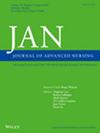Death and Dying in the Emergency Department: A New Model for End‐of‐Life Care
IF 3.8
3区 医学
Q1 NURSING
引用次数: 0
Abstract
BackgroundDeath and dying remain taboo subjects in society today and therefore people may come to the end of their life without having thought about what death and dying might be like and what it is to have a good death. The purpose of this qualitative study was to understand the experience of death and dying in a hospital emergency department. Culturally, some individuals are unprepared for death, and when death occurs in an emergency setting it can be particularly shocking.MethodsA phenomenological study was undertaken, based on the existential phenomenology of Merleau‐Ponty; and framed by the nurse theorist Hildegard Peplau. Bereaved relatives and registered nurses gave in‐depth interviews describing their experiences and the interviews were analysed using an adaptation of the work of Thomas and Pollio (2002) and Hycner (1985), consistent with Merleau‐Ponty's theories.ResultsThe study brings new understanding of what it is like to die in an emergency setting through new understanding of what the accompanying relatives/friends of the deceased person experience, aided by new understanding of the experiences of emergency nurses.ConclusionsA nursing model based both on the work of Peplau (Parse et al. 2000) and on the work of the nurse theorists Ruland and Moore (1998) and Zaccara et al. (2017) was devised for use in the emergency department when death occurs. It is hoped that this model will help nurses improve the care given to this group of patients and their loved ones.急诊室中的死亡与濒死:临终关怀的新模式
背景死亡和临终仍然是当今社会的禁忌话题,因此人们可能在生命即将结束时还没有想过死亡和临终可能是什么样的,也没有想过什么是美好的死亡。这项定性研究的目的是了解医院急诊科的死亡和临终体验。在文化上,有些人对死亡毫无准备,而当死亡发生在急诊环境中时,可能会特别令人震惊。研究方法以梅洛-庞蒂(Merleau-Ponty)的存在现象学为基础,以护士理论家希尔德加德-佩普劳(Hildegard Peplau)为框架,开展了一项现象学研究。丧亲者和注册护士进行了深入访谈,描述了他们的经历,并根据梅洛-庞蒂的理论,采用托马斯和波利奥(2002 年)以及海克纳(1985 年)的研究成果对访谈进行了分析。结论根据 Peplau(Parse 等人,2000 年)的研究成果以及护士理论家 Ruland 和 Moore(1998 年)和 Zaccara 等人(2017 年)的研究成果,我们设计了一个护理模型,用于急诊科发生死亡时的护理工作。希望该模型能帮助护士改善对这类患者及其亲人的护理。
本文章由计算机程序翻译,如有差异,请以英文原文为准。
求助全文
约1分钟内获得全文
求助全文
来源期刊
CiteScore
6.40
自引率
7.90%
发文量
369
审稿时长
3 months
期刊介绍:
The Journal of Advanced Nursing (JAN) contributes to the advancement of evidence-based nursing, midwifery and healthcare by disseminating high quality research and scholarship of contemporary relevance and with potential to advance knowledge for practice, education, management or policy.
All JAN papers are required to have a sound scientific, evidential, theoretical or philosophical base and to be critical, questioning and scholarly in approach. As an international journal, JAN promotes diversity of research and scholarship in terms of culture, paradigm and healthcare context. For JAN’s worldwide readership, authors are expected to make clear the wider international relevance of their work and to demonstrate sensitivity to cultural considerations and differences.

 求助内容:
求助内容: 应助结果提醒方式:
应助结果提醒方式:


